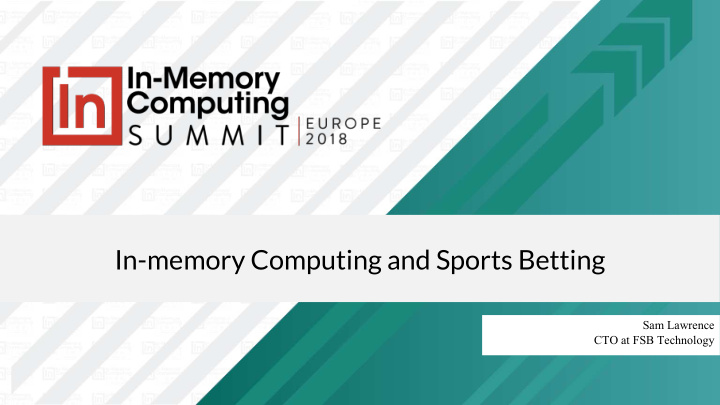



In-memory Computing and Sports Betting Sam Lawrence CTO at FSB Technology
Keynote Abstract ◼ Competition, innovation, regulation and improved data collection have grown the complexity of Sports Betting systems at an unprecedented rate. Coupled with a massive growth in transaction volumes, Sports Betting provides a great case study for considering the relationship between technological advance and business need. ◼ This presentation is a personal look at the technical challenges the industry has faced, the solutions implemented by FSB Tech and some best guesses of likely crunch points in the future.
Introduction - Sam Lawrence ◼ CTO and co-founder at FSB Technology, previously CTO at GAN ◼ 18 years in gaming industry ◼ Started programming as 9 year old on Sinclair ZX81 ◼ Still fairly “hands-on”, but happily more hazy on the details as the company grows ◼ Appeared on the cover of “Your Computer” in 1985
Presentation Summary 1. Sports Betting Technology - history and challenges 2. FSB’s approach and experience 3. In-Memory Computing - what I’ve learnt 4. Wrapping up
1. Sports Betting Technology - history and challenges A blend of maths, finance, sport and technology ◼ Basic premise, money in a hat, winners share based on race or match result ◼ Parimutuel or Tote betting ◼ Early C. 20th used mechanical solutions ◼ Fixed odds provide more betting options without liquidity problems ◼ Online has transformed the industry - more bets taken, more sports covered, more ways to bet The world’s first parallel automatic totalisator - Ellerslie Racecourse New Zealand 1913 (http://rutherfordjournal.org/article020109.html)
Fixed odds betting needs accurate prediction models ◼ 1 / probability … but with margin or “overround” ◼ Complex Models, controlled by key parameters ◼ Faster / richer input data ◼ live sports data ◼ customer activity ◼ other bookmakers - avoiding arbitrage ◼ human traders ◼ Computing has given more techniques, but hasn't changed much of the underlying maths From the “Poisson distribution” page on Wikipedia
Challenges for building a Sports Betting Platform ◼ Volatility ◼ one-off sporting events ◼ Saturday afternoon ◼ Regulation ◼ protecting customers ◼ data protection ◼ spotting money laundering ◼ maintaining integrity in sport ◼ New Products ◼ e.g. Cash Out and Request a Bet ◼ Competition ◼ Welcome offers ◼ Odds Comparison Picture of an automatic transmission valve body
Why is this relevant? ◼ Rapid change created opportunity ◼ Also presented many problems to solve ◼ Same problems faced by other industries ◼ Still need to innovate, not just react ◼ Because it’s the World Cup
2. FSB’s Approach and Experience ◼ Provides sports betting as a service ◼ White label websites ◼ Bespoke implementations ◼ Developer and Operator ◼ Founded in 2007, originally focused on providing Fantasy Sports ◼ Launched first fully responsive site in 2014 ◼ Now run 36 branded sites in 11 different countries in 4 continents
Simple beginnings 2008 - 2010 ◼ Proof of concept platform Glassfish EJB / JMS / ◼ PostgreSQL database JPA ◼ GlassFish application server ◼ Lots of JMS ◼ Choice of open-source technologies with route to enterprise support PostgreSQL ◼ Caching and distribution of data with JPA
Growing pains and patches c. 2010 - 2014 ◼ OpenJMS replaced with ActiveMQ Glassfish EJB / JMS / JPA ◼ Scope of JPA restricted - buggy and slow at high Karaf + Memcached Camel volumes ◼ Caching of sports data via memcached ◼ MongoDB for document based data structures ◼ Added ESB with karaf / camel for external data interfacing MongoDB PostgreSQL
Ready for growth c. 2014 - present Wildfly / ActiveMQ ◼ GridGain caching and processing bespoke data EJB / JMS / JPA MyBatis ◼ sports data - more reads than writes Karaf + Camel GridGain ◼ fast risk and liability calculations ◼ GridGain for distributed locks ◼ PostgreSQL still “master” - final safeguard for data integrity ◼ Scale horizontally adding VMs ◼ Now run 9 different instance of platform MongoDB PostgreSQL
Where does FSB’s Technology go next? ◼ Platform stable and scalable - much new development driven by customers ◼ The need to keep innovating ◼ Entrepreneur’s / CTO’s mindset? ◼ But how to measure value? ◼ Bigger customers want more “Enterprise” guarantees ◼ Security, DR, minimal downtime Growing a business takes patience
3. In-Memory Computing - what I’ve learnt ◼ The key drivers ◼ Increase performance ◼ Handle richer / faster data ◼ Allow horizontal scaling ◼ Redundancy ◼ Relationship with storage ◼ Faster / cheaper ◼ Data that needs to be kept ◼ Data that can’t be kept too long ◼ Persistent memory
What questions did I ask when looking for a solution? ◼ Performance ◼ Redundancy ◼ Scale with needs / volume ◼ Cost / benefits ◼ Community ◼ Support ◼ Development
What about the developers? ◼ Okay, you want to do In Memory computing ◼ Do you need a different mindset? ◼ What framework should you use? ◼ ...Events ◼ ...Streams ◼ ...Services ◼ ...Big data ◼ How do you develop? ◼ Use DevOps tools - ansible, VirtualBox ◼ How do you test? ◼ Concurrency issues are hard! John Backus 1978 - “Can Programming Be Liberated from the von Neumann Style? A Functional Style and Its Algebra of Programs”
4. Wrapping up ◼ Sports Betting is an exciting industry for tech ◼ In-Memory computing was essential to enable scale ◼ Relieved to have a firm foundation, but still many problems to solve ◼ Excited about the future
Thank you! ◼ Sam Lawrence ◼ CTO at FSB Technology ◼ sam@fsbtech.com
Recommend
More recommend